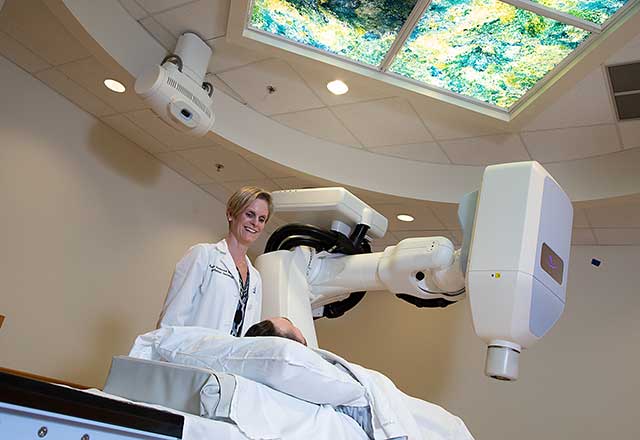Types of Treatments

The experienced radiation oncology team specializes in treating a variety of cancers with a number of radiation therapy options, including proton therapy. All these therapies use high energy, penetrating waves or particles to destroy cancer cells or keep them from reproducing. Your medical team will determine the most effective options for you.
Our treatments fall in several types:
Proton therapy
Proton therapy is a form of targeted radiation treatment that uses energy from positively charged particles called protons. Protons very precisely zero in on tumors, delivering most of their cancer-fighting energy directly to cancer cells while minimizing radiation exposure and damage to neighboring healthy tissue and organs. The therapy reduces the risk of late effects after treatment.
Because of its precision, proton therapy makes it possible to treat cancers near delicate organs, such as the spinal cord and heart, and offers a new treatment approach for recurrent cancers. It also provides a safe and effective way to treat cancers that present a challenge because of their location in the body, such as brain cancer and cancers in the eye or base of the skull and neck.
Learn more about Johns Hopkins Proton Therapy Center.
External beam radiation
External beam radiation delivers a beam of high energy X-rays to a patient’s tumor site to destroy cancer cells. The technique gets its name from the fact that the beams come from an external source (a machine called a linear accelerator) and are aimed at the site of the tumor.
There are several types of external beam radiation used at Johns Hopkins. They include:
- Image-guided radiotherapy (IGRT) – This technique uses frequent imaging to display the cancer site, allowing experts to provide highly precise and accurate delivery of the radiation. The radiation oncologist can create and view images of the tumor site before and during the time radiation is delivered. IGRT is particularly helpful for cancer sites in parts of the body that move (such as the lungs) or sites near major organs and tissues that should not receive radiation (such as the heart or kidneys).
- Intensity-modulated radiation therapy (IMRT) -- This radiation technology uses computer-controlled radiation beams in conjunction with three-dimensional computed tomography images of the tumor site and surrounding areas. IMRT delivers targeted radiation doses to the tumor site, patterned to match the shape of the tumor through modulating the intensity of the radiation beams. This means the tumor site receives the high doses needed to destroy cancer cells while sparing surrounding organs and tissue.
- 3D Conformal Radiation Therapy – For this technique, imaging scans are used to create a three-dimensional model of the exact shape and size of the tumor. Then multiple radiation beams are aimed at the tumor shape, sparing nearby healthy tissue.
- Volumetric Modulated Arc Therapy (VMAT) – Single or multiple radiation beams sweep around the patient, greatly reducing treatment time. Three-dimensional imaging technology aids in the precision of radiation delivery, giving doctors the ability to visualize the tumor at the time of treatment.

Stereotactic Radiosurgery
Despite the name, this treatment is a nonsurgical radiation therapy that can be used as an alternative to invasive surgery. The technology delivers multiple radiation beams from different angles and planes. Three-dimensional images are used to determine the exact location of the tumor. This treatment can treat very small tumors or those located in hard-to-reach places.
- Fractionated Radiosurgery (FRS) uses the same technologies but treatments may be spread out over several days using lower doses of radiation.
Stereotactic Body Radiation Therapy (SBRT)
This treatment administers very high doses of radiation using several beams of different intensities, and aimed at different angles to target the tumor. The therapy can be given as a single dose or up to several doses.
- CyberKnife, a type of SBRT, uses a robotic arm to deliver radiation in different ways and at different angles.
Internal Radiation Therapy at Johns Hopkins
Brachytherapy (low-dose rate and high-dose rate): Brachytherapy is a targeted radiation treatment that uses a special needle or catheter to deliver radioactive “seeds” or another radiation source of focused radiation to a tumor. The seeds or radiation source may be inserted just for several minutes or hours and then removed with high-dose rate, as is used often for gynecologic cancers, or left inside the body to release radiation over time with low-dose-rate radiation, as is often used for prostate cancer. At Johns Hopkins, we use brachytherapy to treat prostate, gynecological, head and neck, and other cancers. Uveal melanoma is treated with eye plaque brachytherapy. Brachytherapy can be used as an alternative to surgery to spare organs or in addition to surgery to help decrease the chance of a cancer coming back. Our experts continue to advance this treatment with unique MRI-assisted approaches for both gynecologic and prostate cancer treatments, and provide cutting edge approaches to treatment using real-time MR-guided brachytherapy.
Intraoperative radiation therapy provides an intensive, targeted dose of radiation to a tumor site during surgery, after the tumor is removed, to sterilize the area where the tumor was located. It is often given after standard radiation therapy and has been shown to decrease the chance of the cancer coming back. This therapy is particularly effective at treating recurrent tumors and large tumors that adhere to normal tissues. It may cause fewer side effects than traditional external beam radiation treatment.
Radio embolization: Radio embolization uses tiny glass or resin beads called microspheres to deliver radiation to a tumor through the bloodstream. These particles are placed inside blood vessels, where they travel to the tumor and deliver a high dose of radiation. TheraSphere is one type of radio embolization used at Johns Hopkins to treat liver cancers.
Active Breathing Coordinator (ABC)
ABC is an interactive device that coordinates breathing during treatment because tumors can shift up and down as a person breathes. This tool, invented by a Johns Hopkins Kimmel Cancer Center physicist, locks the breath in place for a short, comfortable period to deliver radiation during the optimal times of the breathing cycle.
Radiopharmaceutical Therapies (RPT)
Learn more about Radiopharmaceutical Therapies (RPT). RPTs are systemic treatments that target cancer cells with a radioactive drug. Other terms for RPT include radioligand therapy, molecular radiotherapy, or theranostics. We specialize in multiple types of RPTs including Pluvicto (177Lu-PSMA-617) for prostate cancer, Xofigo (Radium-223) for prostate cancer, and Theraspheres (90Y-microspheres) for cancers involving the liver.
